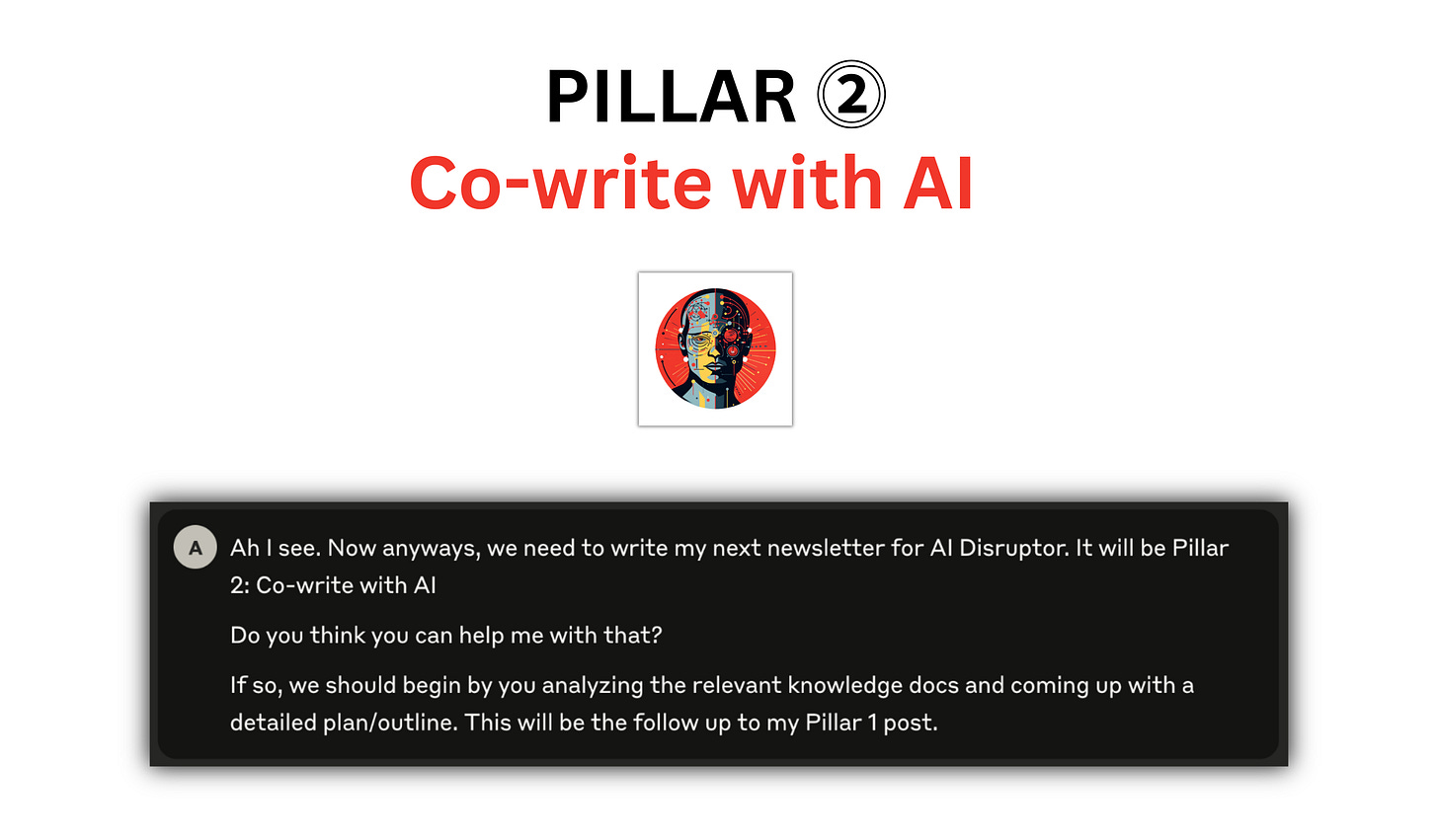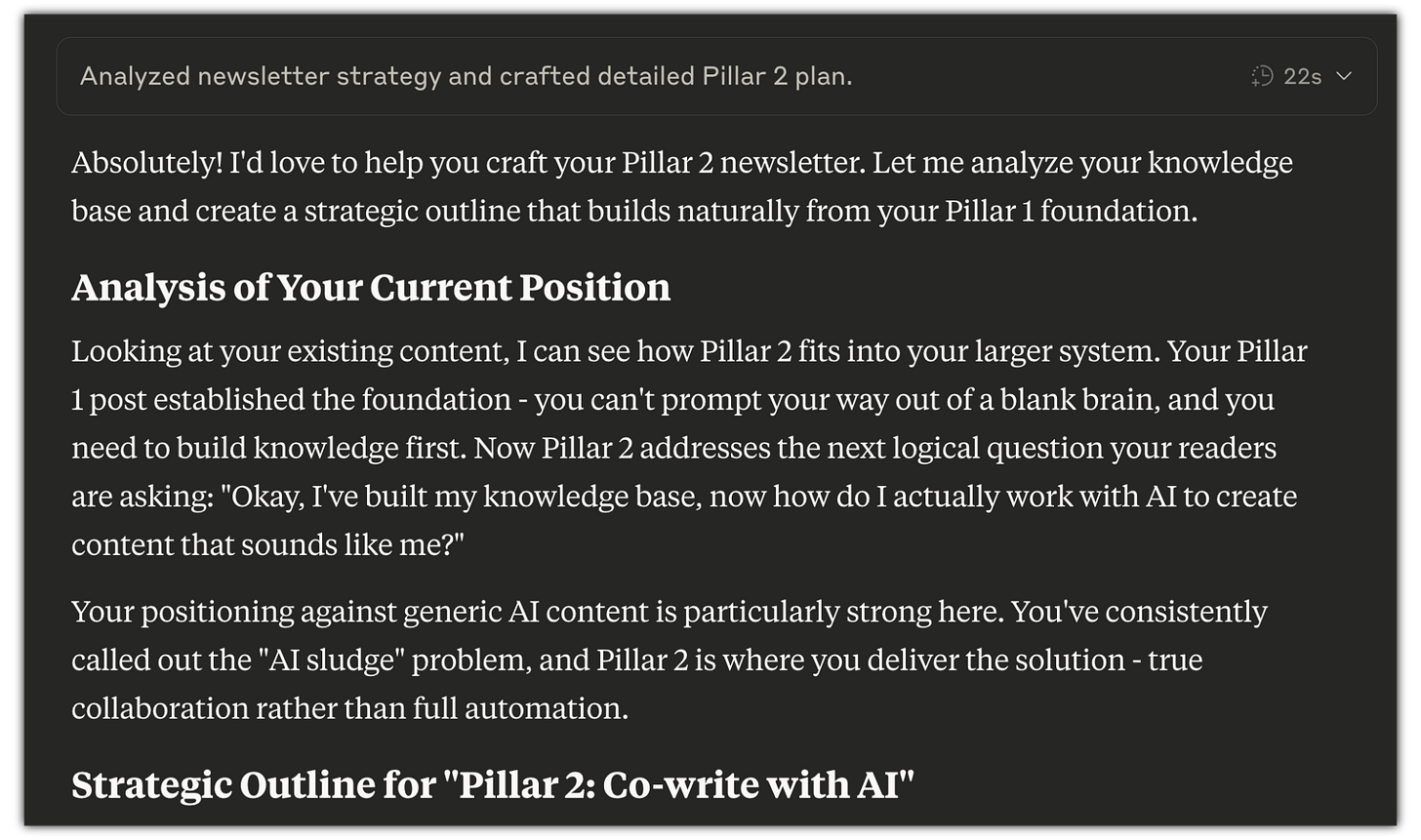In Pillar 1, we talked about building your knowledge base.
Once you've fed your AI everything it needs to know about your voice, your audience, your frameworks, uploaded your best writing samples, and created those detailed brand documents, things start to get interesting.
With that knowledge base in place, an entire new world of co-writing with AI opens up. You're no longer starting from scratch with generic prompts. Instead, you can reference specific frameworks, focus your AI's attention on what really matters for your work, and have conversations that build on everything you've already taught it.
This is where the real collaboration begins.
Not familiar with my 3-pillar AI writing system yet? → Read this first
The 80/20 rule of AI collaboration
Let me be clear about something: effective, systematic prompts with proper context will get you about 80% of the way there. Yes, 80%.
When your AI knows your voice, understands your audience, and has access to your frameworks, a well-structured prompt becomes incredibly powerful. You're not just asking for generic content anymore. You're asking your AI to work within the parameters of everything you've built together.
But that remaining 20%? That comes from iteration, refinement, and the kind of back-and-forth dialogue that turns good content into content that truly stands out.
We are not replacing prompting. We are just taking a systematic approach to it.
What changes when you have context
Here's what I've learned from ghostwriting for AI founders and building my own newsletter: when your AI has proper context, everything shifts.
Instead of generic instructions, you can say things like:
"Use the framework from my (X) strategy doc, but write it in the tone from my best-performing newsletter about (X). My audience already understands the basics, so focus on the advanced implementation."Your AI doesn't just understand what you want. It understands how you think.
That's the difference between using AI tools and building an AI writing assistant that actually knows you.
How I actually write (it might surprise you)
Here's something you probably wouldn't have guessed about my process:
I spend most of my time having conversations with my AI rather than crafting elaborate prompts each time.
I'll start with one of my systematic, task-based prompts (the kind I keep in my Prompt Vault for exactly these situations).
Then I start chatting with the AI. It responds with ideas based on everything it knows about my voice, my audience, and my approach. I react to those ideas, suggest changes, add my own perspective, and we go back and forth until we've built something that feels authentically mine.
The systematic prompts get us started. The conversation gets us to the finish line.
Understanding the collaboration spectrum
Think of AI collaboration as existing on a spectrum, not as a binary choice between automation and manual work.
On one end, you have pure automation: hit a button, get content, hope it works. This rarely produces anything worth publishing because it lacks the nuance that makes content compelling.
On the other end, you have pure manual work: writing everything yourself without any AI assistance. This gives you complete control but sacrifices the speed and structural thinking that AI provides.
The sweet spot lies in the middle: systematic prompts that leverage your knowledge base, followed by iterative conversations that refine and personalize the output.
The prompt draws on specific knowledge my AI has about me.
Then I can take that output and say:
"This is good, but I want to make it more specific about (X). Can you revise it to assume readers have already done (X)?"We iterate until it’s exactly where I want it.
The reference advantage
This is where having a proper knowledge base becomes transformational. Instead of explaining your entire approach every time, you can reference existing frameworks, successful pieces, or specific examples your AI already knows about.
"Write this using the same structure as my newsletter about content repurposing, but focus on the collaboration angle instead.""Apply the tone from (X) post about AI systems, but make it more technical for this audience.""Reference the framework from my client work with [Company X], but adapt it for solo creators instead of teams."Your AI doesn't just follow instructions. It builds on the foundation you've created together.
Why this matters for your content
While everyone else is racing toward full automation, you're developing a collaborative process that actually enhances your voice rather than replacing it.
The result is content that stands out because it carries real perspective, not just information. Your audience can tell the difference between something you've collaborated on and something that was generated automatically with 0 input from you.
More importantly, this approach scales with you. As you develop new ideas, work with new clients, or evolve your thinking, your AI learns and adapts. The collaboration gets better over time instead of staying static.
What happens next
Next up, we'll explore Pillar 3: Scale the output.
Because once you've mastered this collaborative approach, you can turn one piece of content into dozens of formats and platforms while maintaining your unique voice throughout. That's where the real leverage begins.
The creators who master this balance between systematic prompts and iterative refinement will have a significant advantage while others are still stuck choosing between automation and manual work.
Alex
Founder of AI Disruptor







@Alex Dobrenko`